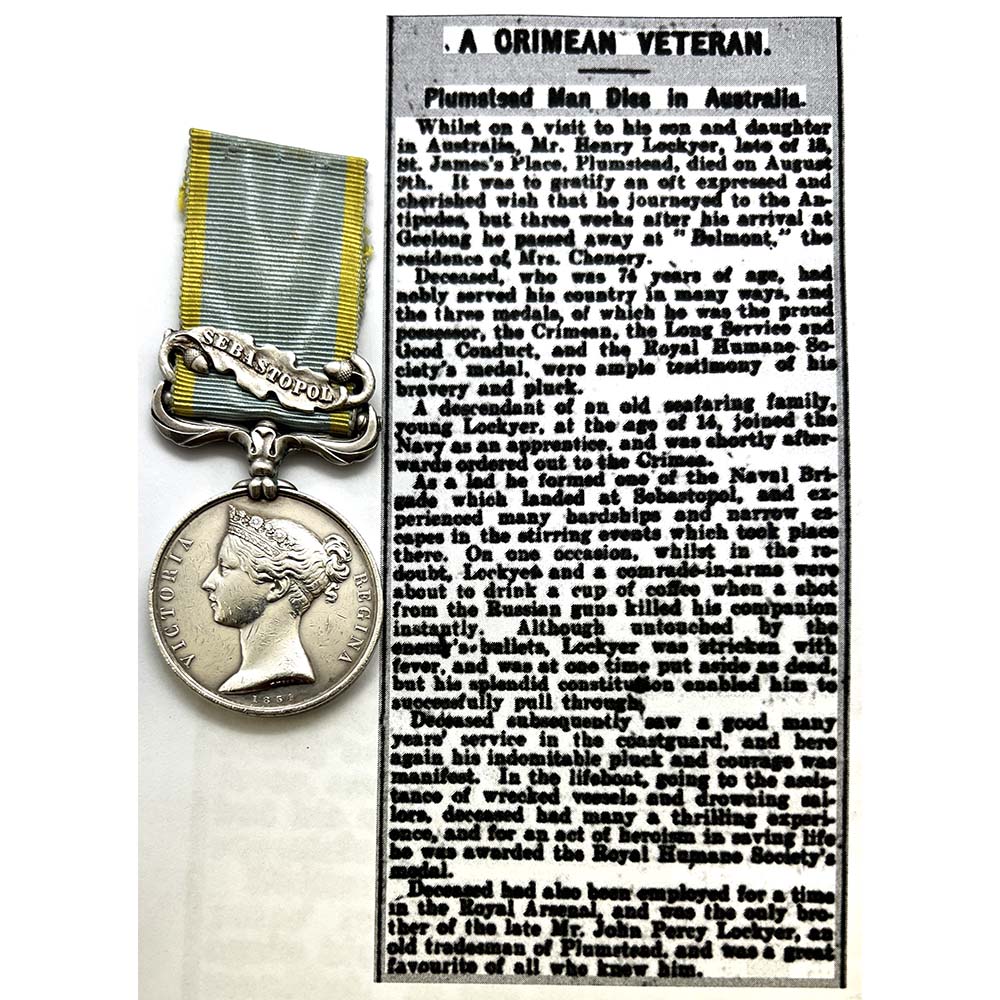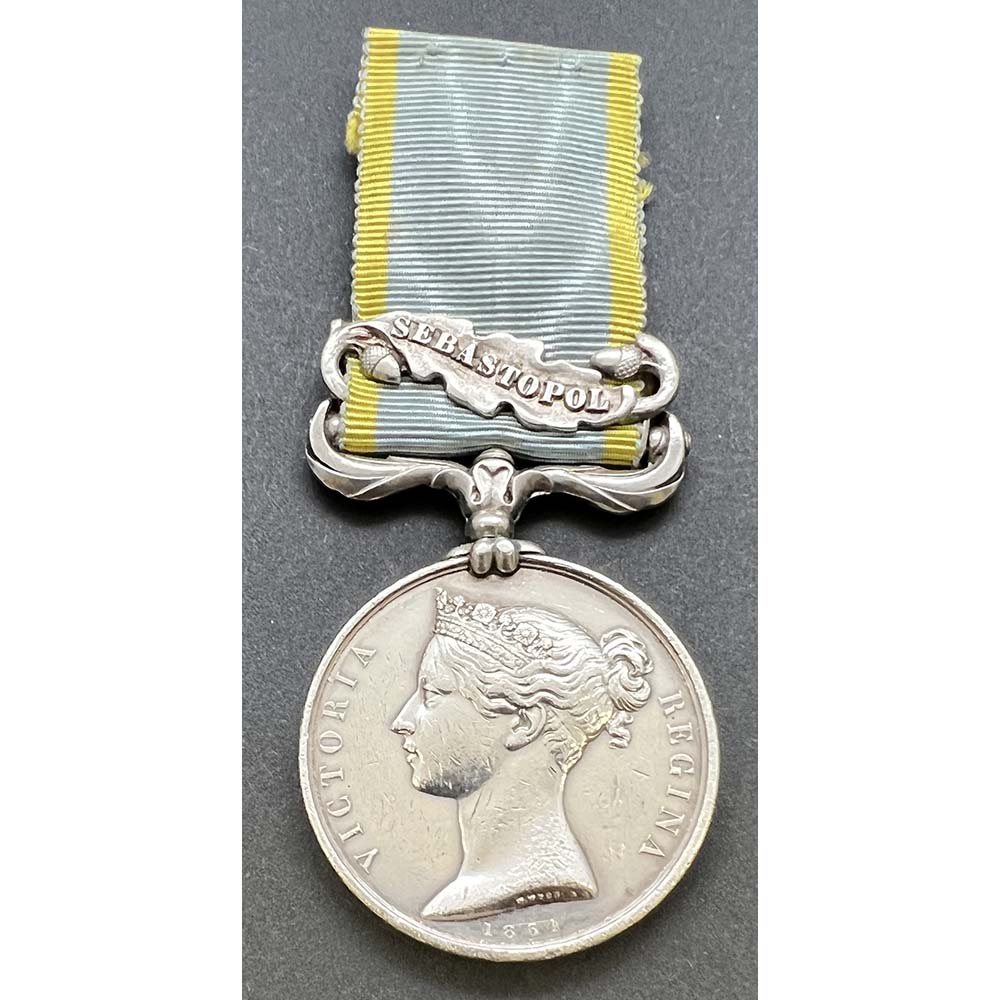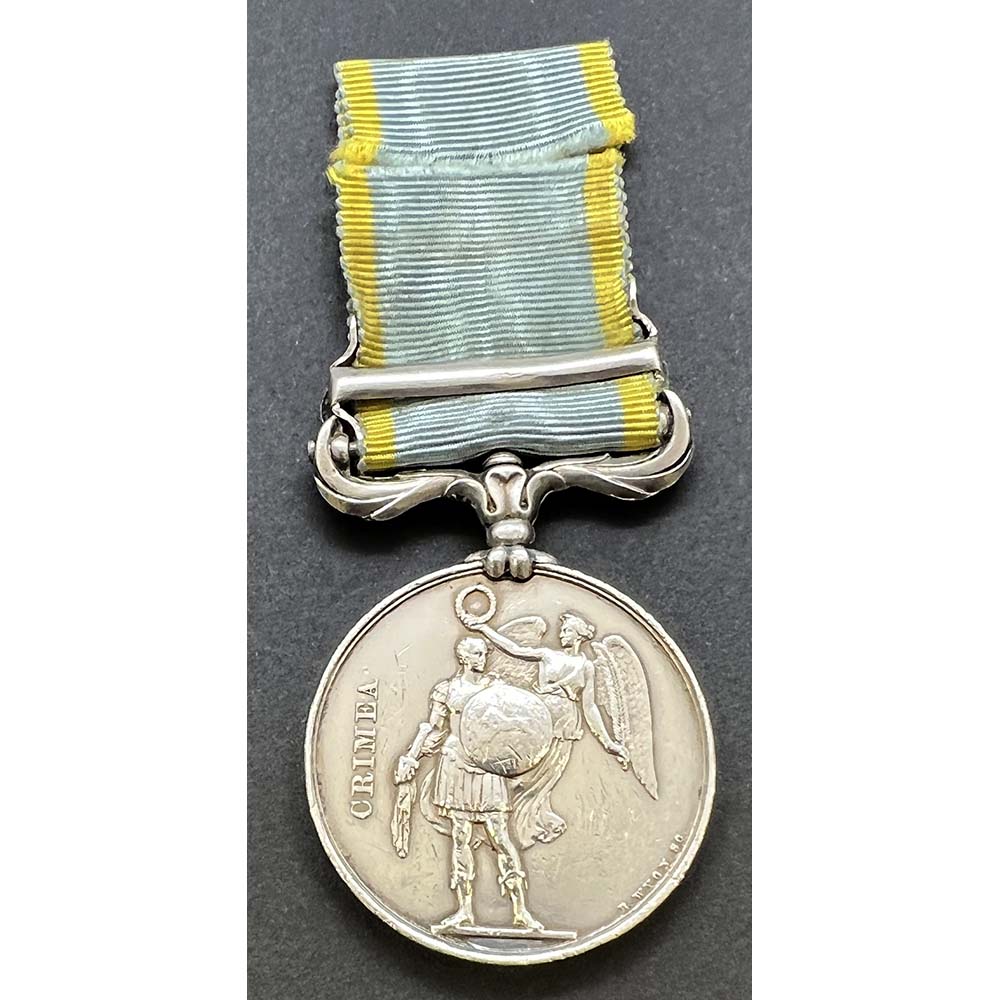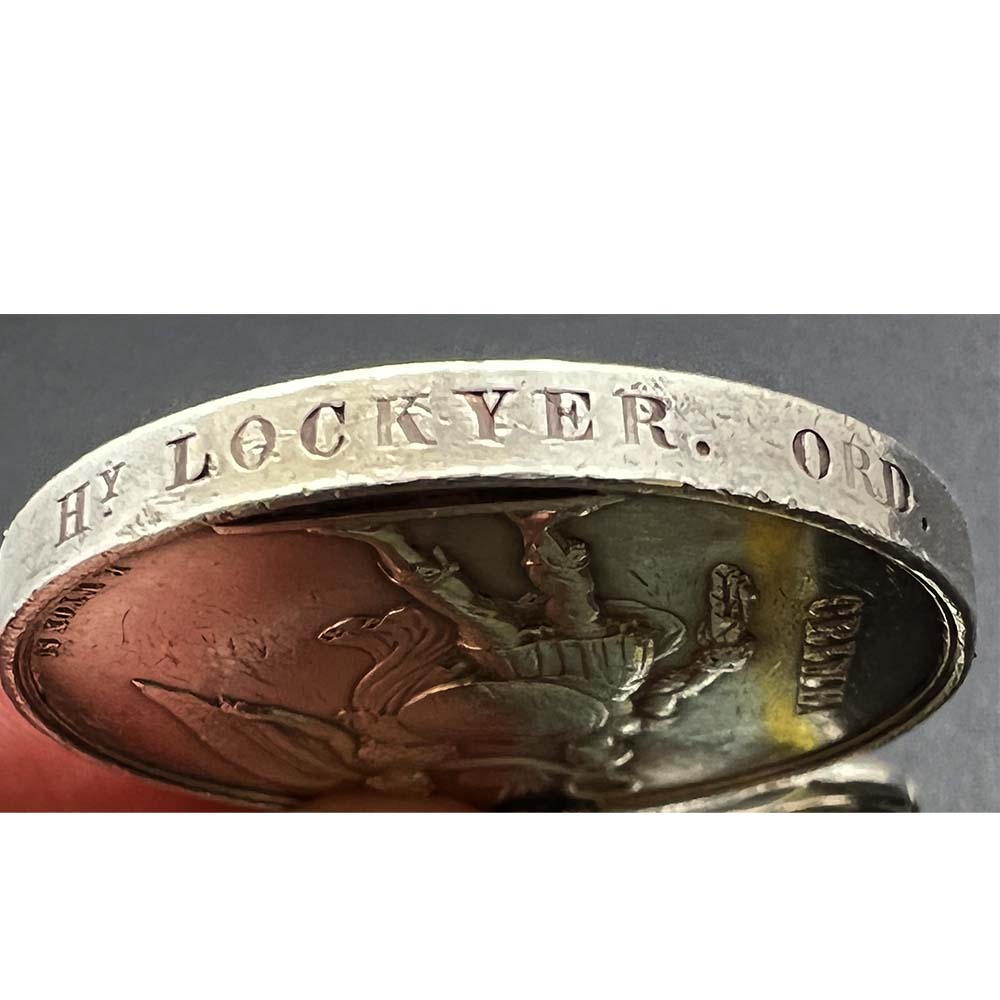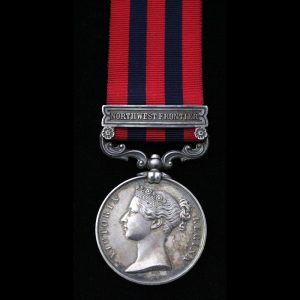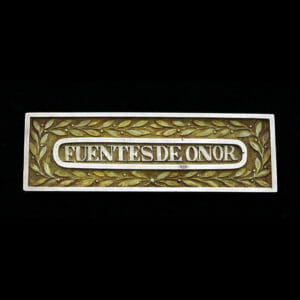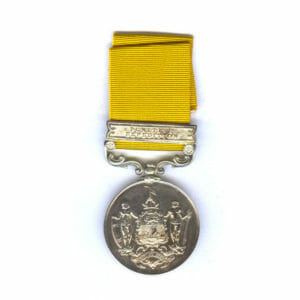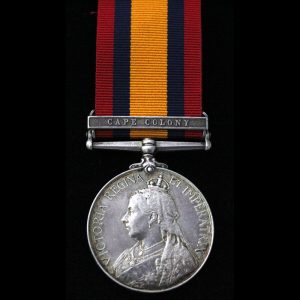Description
Crimea, bar Sebastopol, Henry Lockyer, Ordinary Seaman, HMS London.
Officially impressed: “Hy Lockyer Ord.” A rare officially named medal as awarded to HMS London, who saw service ashore with the Naval Brigade.
With full copy service papers from 1852-1884.
Provenance, sold alongside his Naval LSGC Medal in Spink on 6th May 1998, so should be out there for a reunite.
Henry Lockyer joined up as a young 14 year old, at 18 he was in trenches at Sebastopol with the Naval Brigade from HMS London, where he was almost killed in the redoubt by a bullet that instantly killed his comrade right infront of him and had been at one time “Put aside as dead” whilst stricken with fever.
After Crimea, he joined HMS Trident, who was sent to the West Coast of Africa by Sierra Leone on Anti Slavery duties for 3 years, where they detained a number of ships and gathered information on various ships being equipped for slave transportation, also rendering salvage service to the Agnes during 1857.
On 29th May 1858 she captured the Lydia Gibbs, which had attempted to depart Wydah for Aghwey, when it was stopped by the Trident, her papers and colours had been thrown overboard, information being gathered that she was due to pick up a number of slaves soon afterwards. She was condemned at the Admiralty Court in Sierra Leone in July.
He then found himself beginning a long career with the Coast Guard, he went from Boatman, to Commissioned Boatman, earning the Naval LSGC, before becoming a Chief Boatman by the time of his retirement, having amassed about 32 years of service to the Navy.
His lengthy obituary which recalls his adventurous life and lifeboat heroism that earned him the Royal Humane Society Medal and is well worth a read, published in the Woolwich Gazette, 21st September 1909:
“A CRIMEAN VETERAN, A Plumstead Man died in Australia.
Whilst on a visit to his son and daughter in Australia, Mr Henry Lockyer, late of 18, St James Place, Plumstead, died on August 9th.
It was to gratify an oft expressed and cherished wish that he journeyed to the Antipedes, but 3 weeks after his arrival at Geelong he passed away at ‘Belmont’ the residence of Mrs Chenery.
The deceased, who was 74 years of age, had nobly served his country in many ways, and has 3 medals, of which he was the proud possessor, the Crimean, the Long Service and Good Conduct, and the Royal Humane Society’s Medal, they were ample testimony of his bravery and pluck.
A descendant of an old seafaring family, the young Lockyer, at the age of 14, joined the Navy as an Apprentice and was shortly afterwards ordered out to the Crimea.
As a lad he formed part of the Naval Brigade which landed at Sebastopol, and experienced many hardships and narrow escapes in the stirring events which took place there.
One one occasion, whilst in the redoubt, Lockyer and a comrade in arms were about to drink a cup of coffee when a shot from the Russian Guns killed his companion instantly.
Although untouched by the enemy’s bullets, Lockyer was stricken with Fever, and was at one time put aside as dead, but his splendid constitution enabled him to successfully pull through.
The deceased subsequently saw a good many years service in the Coastguard, and here again his indomitable pluck and courage was manifest.
In the lifeboat, going to the assistance of wrecked vessels and drowning sailors, deceased had many a thrilling experience, and for an act of heroism in saving life, he was awarded the Royal Humane Society’s Medal.
Deceased had also been employed for a time in the Royal Arsenal, and was the only brother of the Late Mr John Percy Lockyer, an old tradesman of Plumstead, and was a great favourite of all who knew him.”
A local obituary in the Geelong Advertiser, reports his honourable burial, flying the Union Jack 12th August 1909:
“Mr Henry Lockyer, who died on Monday, had served 33 years in the Royal Navy, and was with the Naval Brigade in action at Sebastopol. He also had 15 years of voluntary service with the lifeboats on the Dungeness Coast, Sussex, England, and was instrumental in saving many lives.
Deceased had several medals, including the Crimean Medals, The Sebastopol bar and the Turkish Medal.
The internement of his remains took place yesterday in the Church of England portion of the Highton Cemetery. The Union Jack was used as a Pall, and was supported by Messrs F-Godfrey, D. D’arcy, T. Bush, R. Bursh. C. Bush and R. Purnell.
The deceased had only arrived 3 weeks ago from England on a visit to his Daughter. Mrs Chenery, of Belmont.
The Reverend Weire was the officiating clergyman, and the funeral arrangements were supervised by Messrs WB King and Son.”
Mr Henry Lockyer was born in Christchurch, Hampshire on 10th October 1837.
By the time he was discharged to pension in 1st April 1884 he had risen to the rank of Chief Boatman.
He had first joined the navy as a young Teenager at HMS Victory on 7th September 1852.
His first ship posting came on HMS London, 1st October 1853, serving on board until 26th January 1856, throughout the Crimean War.
Joined HMS Ringdove until 3rd November 1856.
Then joined HMS Trident from 4th November 1856 until 12th november 1859. (4 Years 35 days service), During this time deployed to the West Coast fo Africa under command of Francis Arden Close.
Admiral Francis Arden Close, a classic looking Victorian Naval Officer, who sported the popular “Mutton Chops” Moustache combo look of his day, an interesting Captain to have, his father had founded Cheltenham College. He had risen the ranks of the Navy when he was promoted and decorated for service in the Crimean War.
For this he rewarded with a 3 year commission as Senior Commander on the West Coast of Africa, on board HMS Trident.
In 1858, he would be recommended for “very judicious conduct” for having “carried out important duties on secret service at Lagos.”
The cited event was reported home by Captain Close, involving the discovery of a hidden creek, concealed from Men-of-War Boats, the Cutter was sent out to scout the inlets up the River Pongas to Cape Verga, the captain found evidence of the slave trade and launched n investigation:
14 Oct 1858, sent the second cutter up the creeks and inlets up the River Pongas to Cape Verga who returned after 6 days, following which Captain Close produced the following report:
A creek was discovered where slavers had been successfully concealed from men-of-war boats. The cutter heard that an American vessel landed a cargo last month opposite Tintima, but was frightened away out of the river by the report of men-of-war’s boats being in the neighbourhood. The cutter, wishing to visit this place, were told that no stranger could land there. It is well known that strangers are never permitted to approach the locality of barracoons; and I have since obtained information that slaves are held by Karrata Marra in this place for export trade.
I have received a great deal of information from two slaves who very recently escaped from the barracoons of Mrs Lightbourne and Mr. Faber. They assured me that Mrs. Lightbourne’s daughter, who lives opposite to Farrangia has no dealings with the export slave Trade. The slave from Mr. Faber’s barracoons states that two months ago Mr Faber embarked 200 or 300 slaves in a Spanish vessel commanded by a man named Minette. She was concealed in a creek at the Sandbar, and the slave was employed on board her to watch.
He had been ten years a slave to Mr. Faber, five of which he had spent in chains. Latterly they had trusted him to watch, and to buy slaves on two occasions for Mr. Faber.
On the last occasion, his money and boat had been taken from him by the natives of the Scarcies river, and, fearing to return to his master empty-handed, he ran to Sierra Leone.
In addition the follow was appended : on my recent visit to Matacong, I heard that, two months ago, a Spanish vessel anchored off the island ; the captain landed, and was advised by Mr. Reader, an English merchant, to go away, as it was not safe for him to be there. Mr. Reader is supposed not to be so honest as he should be, and is also suspected of aiding and abetting the Slave Trade ; he is acting in trade for a person of the name of Isaacs, who was obliged to run from Matacong; a writ being issued against him by Governor Kennedy for slave-dealings.
22nd October 1858, Now at Sierra Leone, departed for the Pongas and obtained positive information of slaves and barracoons existing in the neighbourhood of Mrs Lightbourne’s premises, upwards of 700 having been seen all changed and ready for embarkation.
HMS Marlborough, 26th November 1861 – 1st December 1864. During this time promoted to Leading Seaman, 24th July 1864.
Some notes on service: Employed for service on the Mediterranean Station, commissioned 23rd March 1861.
Arrived at Malta, 16th December 1861
An old officer reports on his time aboard circa 1862: “Marlborough, Flag-Ship in the Mediterranean, This ship was then the acme of Naval splendour, the largest and most powerful fighting machine in existence, perfect in drill and discipline, and one of the “smartest” ships that ever floated, insomuch that her cleanliness and order struck wonder even into our minds, accustomed as we were to a high degree of excellence in all things pertaining to a man-of-war. From the truck to the kelson she was the same – this magnificent three-decker – her sides shining in the sun like a mirror, every one of her one hundred and thirty guns a looking-glass, every particle of brass like polished gold, her decks like snow, her crew as clean, powerful, well-set-up a body of men (one thousand four hundred in all, if I remember aright) as ever served their country. Even to this day, amongst us old hands, the Marlborough’s commission is cited as the apogee of Naval discipline and good order, and certainly, though I am far from being a laudator temporis acti, I confess I have never seen anything like it since. I was a very short time in the Marlborough, being transferred to an ancient vessel, still, I believe, performing the duty of receiving-ship in Malta the Hibernia and from her to a vessel lying in Alexandria the Doris where I joined her, thus obtaining my first sight of a land that had always fascinated me when, as a boy, I had stumbled through Herodotus, wondering if he could be the liar my master at Cheltenham took such pains to make us believe him to have been.”
Next posting after his return from the 3 years on the Mediterranean Station,
HMS Excellent, 2nd Dec 1864 – 14th Dec 1865
HMS Bellerophon, 15th December 1865 – 21st November 1866, an early Central Battery Ironclad Battleship launched in mid 1865. An original Crew Member, she was finally undocked around New Years 1865.
First joined the Coast Guard on 22nd November 1866 as a Boatman.
Commissioned Boatman at Rye Harbour, 1st January 1873 – 20th April 1879
Promoted to Chief Boatman, at Rye Harbour, 21st April 1879 before transferring to Chichester Harbour 28th April 1879
Upon discharged as Chief Boatman at Chichester Harbour, Character stated: “Exemplary”, discharged to his pension 1st April 1884.
Assessment for further service, Rye, Feb 1871:
“I have the honour to inform you that I have this day examined Henry Lockyer Boatman of Rye Harbour Station as to his physical fitness to re-engage to service in the Royal Navy and I beg to report that I consider him to be thoroughly competent and fit for the service.
Signed Surgeon of the Coast Guard at Rye, Edward Adamson.”
